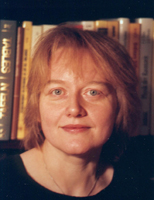


Semiconducting pi-conjugated polymers are promising low-cost and flexible materials for electronic devices such as organic light-emitting diodes (OLEDs) and solar cells. Many of the unique properties of these materials stem from the combination of the molecular structure of their building blocks and the extended nature of the pi-system. Thus, excitonic states, i.e., electron-hole quasi-particle states that are delocalized over several or many monomer units, play a central role for the optoelectronic properties. In the present contribution, we focus on the elementary photophysical events at polymer heterojunctions, which provide highly efficient exciton dissociation sites at the interface between different phase-segregated polymers. A molecular-level, quantum-dynamical analysis of phonon-driven exciton dissociation at a TFB:F8BT heterojunction [1] is presented, using a linear vibronic coupling model parameterized for the three most relevant electronic states and 20-30 vibrational modes [2]. Quantum dynamical simulations were carried out using the multiconfiguration time-dependent Hartree (MCTDH) method, in conjunction with a hierarchical electron-phonon model [2]. The generation of a charge separated state on an ultrafast (femtosecond to picosecond) time scale is shown to depend crucially on the presence of intermediate bridge states, and on the dynamical interplay of high-frequency C=C stretch modes and low-frequency ring-torsional modes. The coherent, highly nonequilibrium dynamics is consistent with time-resolved spectroscopic observations.
[1] A. C. Morteani, P. Sreearunothai, L. M. Herz, R. H. Friend, and C. Silva, Phys. Rev. Lett. 92, 247402 (2004); A. C. Morteani et al., in: \E2??Organic Light-Emitting Devices\E2?\9D, Eds. K. M¨ullen and U. Scherf, VCH-Wiley (2006).
[2] H. Tamura, E. R. Bittner, and I. Burghardt, J. Chem. Phys., 126, 021103 (2007), J. Chem. Phys., 127, 021103 (2007); H. Tamura, J. G. S. Ramon, E. R. Bittner, and I. Burghardt, arXiv:0707.2163 [cond-mat.soft], Phys. Rev. Lett., submitted.



Semiconducting pi-conjugated polymers are promising low-cost and flexible materials for electronic devices such as organic light-emitting diodes (OLEDs) and solar cells. Many of the unique properties of these materials stem from the combination of the molecular structure of their building blocks and the extended nature of the pi-system. Thus, excitonic states, i.e., electron-hole quasi-particle states that are delocalized over several or many monomer units, play a central role for the optoelectronic properties. In the present contribution, we focus on the elementary photophysical events at polymer heterojunctions, which provide highly efficient exciton dissociation sites at the interface between different phase-segregated polymers. A molecular-level, quantum-dynamical analysis of phonon-driven exciton dissociation at a TFB:F8BT heterojunction [1] is presented, using a linear vibronic coupling model parameterized for the three most relevant electronic states and 20-30 vibrational modes [2]. Quantum dynamical simulations were carried out using the multiconfiguration time-dependent Hartree (MCTDH) method, in conjunction with a hierarchical electron-phonon model [2]. The generation of a charge separated state on an ultrafast (femtosecond to picosecond) time scale is shown to depend crucially on the presence of intermediate bridge states, and on the dynamical interplay of high-frequency C=C stretch modes and low-frequency ring-torsional modes. The coherent, highly nonequilibrium dynamics is consistent with time-resolved spectroscopic observations.
[1] A. C. Morteani, P. Sreearunothai, L. M. Herz, R. H. Friend, and C. Silva, Phys. Rev. Lett. 92, 247402 (2004); A. C. Morteani et al., in: \E2??Organic Light-Emitting Devices\E2?\9D, Eds. K. M¨ullen and U. Scherf, VCH-Wiley (2006).
[2] H. Tamura, E. R. Bittner, and I. Burghardt, J. Chem. Phys., 126, 021103 (2007), J. Chem. Phys., 127, 021103 (2007); H. Tamura, J. G. S. Ramon, E. R. Bittner, and I. Burghardt, arXiv:0707.2163 [cond-mat.soft], Phys. Rev. Lett., submitted.